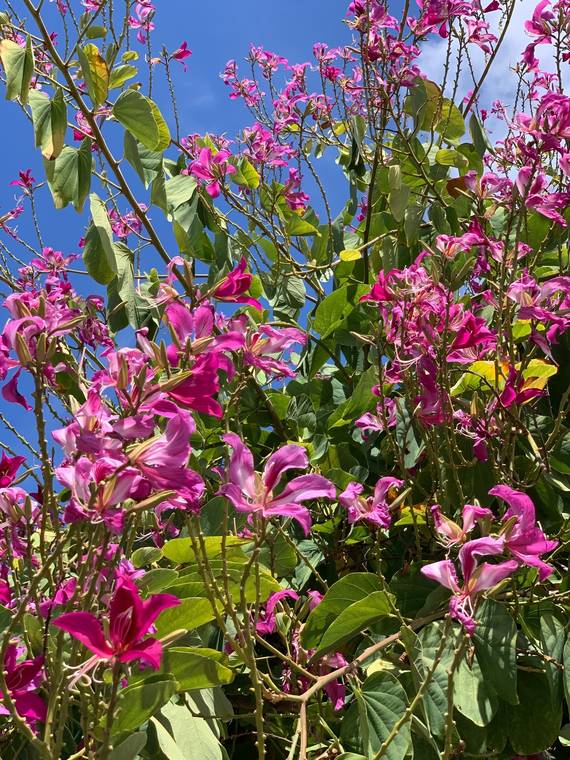The old saying that March comes like a lion and leaves like a lamb usually holds true, but this year, only time will tell. Spring flowering trees are on schedule, like the cherry blossoms of upland Waimea. The Waimea Cherry Blossom Festival is not happening this year due to the COVID-19 pandemic but the trees are still creating a great show. Check them out soon before they disappear for another year. As they begin to fade, blue jacaranda, silver oak and ohia will begin to brighten the landscape. Coffee trees in Kona and other parts of our island are in bloom as well. Later in the spring, royal poinciana and rainbow shower trees will brighten our streets and gardens. The African tulip trees will also be making a spectacular display of red, orange and the rare yellow form as the weather warms.
There was a time when forests covered much of the lands that are now grassland and desert in Hawaii. However, with the introduction of grazing animals, our forests began to shrink. The vast koa forests of the Kohala mountains, Mauka Kona and East Hawaii are now mere remnants of their past glory.
Loss of forests affects the climate making it hotter, dryer and wind-windier. Even areas like Hilo experience extremes of flood and drought when forests are removed.
Lucky for us, some folks know the value of forests and windbreaks. Our progressive ranchers are planting some koa and eucalyptus at higher elevations.
Then there are groups like the Outdoor Circles, 4-H, Scouts and Lions clubs that are doing what they can to reforest. Unfortunately, the Kona Outdoor Circle that did so much to make Kona “clean, green and beautiful” is no longer active. However all it would take to revive this important organization would be to have a few energetic community leaders get the ball rolling. Back in the 1980s there were almost a thousand members that worked with the landscape industry and developers to encourage tree planting, underground utilities, and reduce the number of ugly signs and billboards. These amazing citizens were also involved in the overall planning and development of West Hawaii. Now, well planned areas like Mauna Lani, Waiakoloa, and Mauna Kea Resorts are literally being transformed into tropical oases. The coconut palms planted along Hilo’s bay front, Punaluu Black Sand Beach, the Old Kona Airport and numerous other projects were the result of organized community effort, but all this is just not enough.
So how can we as individuals help beautify and make our environments more enjoyable? One example, is residents in areas like Kaloko Mauka, Kona are getting involved in the Forestry Divisions Forest Stewardship program, Hawaii Island Land Trust and Moku o Keawe.
Even small lots add up. By planting trees in your garden, you can actually change the microclimate and make your neighborhood several degrees cooler in the summer. If you place your trees just right, you can even create a garden climate that is milder during cool, windy periods.
Now let’s look at the tree planting from another angle. Visitors bring millions of dollars to Hawaii each year. Our sunny winter skies are a big attraction. It used to be that our beaches and tropical woodlands were part of that appeal. Now with urban sprawl on Oahu, some of our best beaches are disappearing. Our main salvation from endless asphalt alleys there and here, is abundant landscaping.
Planting trees to give shade and beautify our communities isn’t the complete answer, but it can help. Do an experiment by taking a thermometer around noon to one of our local parking lots and place it in the shade under a tree. Then place it on the asphalt. It will probably read a temperature in the low 80s in the shade and more than 120 degrees in the sun!
In tree planting activities, remember, proper planting is important, as well as a knowledge of the tree’s requirements. Maintenance is the limiting factor as to whether or not street planting is practical. Be sure to choose trees that fit the space in which they must grow.



